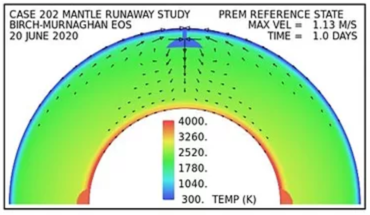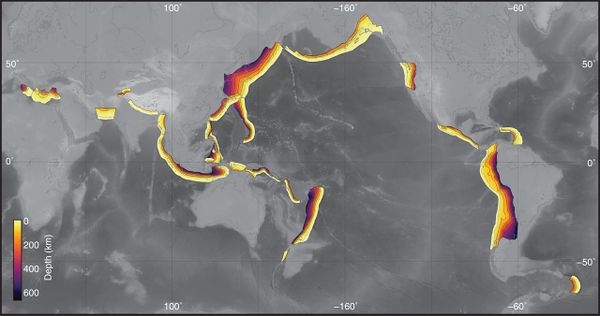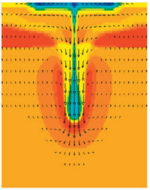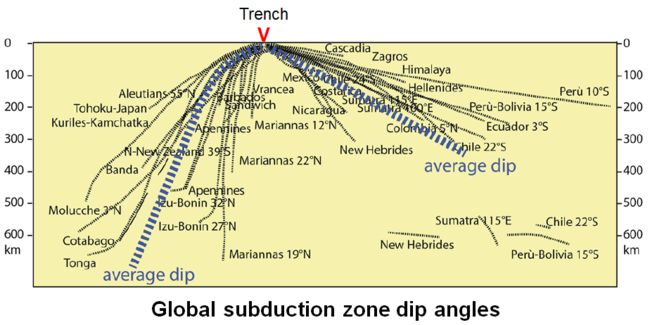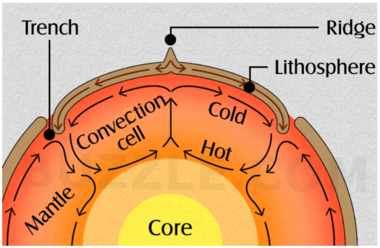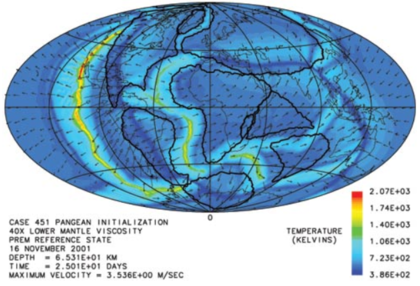Catastrophic plate tectonics
Catastrophic plate tectonics is a theory that proposes rapid movement of the Earth's plates during Noah's Flood by runaway subduction. It was originally derived by Dr. John Baumgardner, and supported by sophisticated computer modeling. It is one of several alternatives to Plate Tectonics theory, which include Expanding earth theory, Hydroplate theory, Hollow Earth, and Shock dynamics geology theory.
Many creation geologists feel it fits with standard geology better than other flood models because it offers a scientific description of the Flood of Noah that is compatible with plate tectonics and continental drift theories. It also provides a mechanism for the source and recession of the flood water (i.e. the fountains of the great deep), and accepts the conventional interpretation of events like earthquakes and volcanic activity. Because it simply requires an accelerated timescale for plate movement, the conflict with traditional uniformitarian geology is also minimal.
Baumgardner's model is illustrated in the 27 minute documentary titled: In the Beginning: Catastrophic Plate Tectonics and the Genesis Flood, which was produced in 1996 by Keziah and American Portrait Films. A critique of Baumgardner's model is illustrated in a 15-minute video titled: Catastrophic Plate Tectonics - a catastrophic geology theory produced in 2020 by the author of the Shock Dynamics geology theory.
Catastrophic Plate Tectonics theory
Catastrophic Plate Tectonics starts with a pre-flood Earth with a single continent and a large ocean. Like the present Earth there were distinct continental and oceanic crusts. The continental crust was the same granite crust that exists today, and the oceanic crust was also basalt. From this starting point Baumgardner models runaway plate subduction producing a viable model of the Genesis Flood. According to this model none of the pre-Flood oceanic crust remains at the surface but has been entirely subducted and replaced with a new basalt crust.[Reference needed]
The process starts with material from the upper mantle suddenly sinking to the lower mantle. The energy of this event is released as heat which changes the mantle's viscosity. This causes the oceanic crust to start to sink because it is denser than the continental crust. This oceanic crust, along with material in the upper mantle, continues to sink, which forces material from the lower mantle upward, pushing up the oceanic crust at about the location of the mid oceanic ridge. With the ends of the oceanic crust near the continent sill sinking, runaway subduction begins. This process splits oceanic crust along what is now the mid oceanic ridge, heat from lava entering this gap heats the water above it causing a super sonic burst of steam (Fountains of the great deep). This steam shoots in to the upper atmosphere where it cools and falls back as a torrential rain. The runaway subduction of the oceanic crust drags down the continental crust causing the water to start flooding the the continent. These processes would cause fast moving currents to move off the continent depositing massive amounts of sediment.[Reference needed]
As the original oceanic crust was subducted it was replaced by a hotter and therefore less dense crust that rose up more, increasing water depth. At some point in the process the strain on the continental crust is so great that it splits apart, this begins the formation of the Atlantic Ocean. As the new oceanic crust cools it starts to sink to a lower level. The runaway subduction comes to a stop as the energy of the original crust sinking to lower mantle is expended. This allows the buoyant continental crust to float up and the flood water to drain off.[Reference needed]
Supporting evidence
- There is a ring of relatively cool material in the lower mantle that corresponds to past and present subduction zones surrounding a hot zone under the Pacific, and hotter material being squeezed up under Africa as predicted by Catastrophic plate tectonics.
- A more recent discovery of a slab of oceanic crust in the lower mantle was also predicted by Catastrophic plate tectonics.
However, dense material in the lower mantle may or may not be correlated with standard Plate Tectonics or Catastrophic Plate Tectonics. There could be an association with the initial coalescing of the Earth or Moon formation.
Obstacles
Catastrophic Plate Tectonics began when "slabs of oceanic crust broke loose and subducted along thousands of kilometers of pre-Flood continental margins."(Austin et al., p612) Yet in Dr. Baumgardner's computer simulation, it begins with the slabs of oceanic crust already subducted about 660 km, or 410 miles. "As to initial conditions, …there is a mound of cold, negatively buoyant rock atop the boundary between the upper and lower mantle at a depth of 660 km." https://www.logosresearchassociates.org/john-baumgardner
He wrote that "One difficulty in making a connection between these calculations and the Flood is their time scale. Some 20 million years is needed before the instability occurs in the second calculation. Most of this time is involved with the accumulation of a large blob of cold, dense material at the barrier created by the phase transition at 660 km depth.”(Baumgardner, p74)
But even in conventional Plate Tectonics, "the question on how to 'break' lithospheric plates and initiate subduction remains a matter of debate. Generally it is thought that oceanic lithosphere densifies as it cools, therefore becoming increasingly negatively buoyant as it ages. At some point, this negative buoyancy should be large enough to prompt the oceanic lithosphere to sink into the mantle, therefore initiating subduction. However, it has been shown that buoyancy forces are too small to bend the lithosphere and overcome the frictional stresses in the fault and that therefore external forces are required to initiate subduction."(Thielmann and Kaus)
While the idea is plausible that weakness along a passive continental margin, such as the current east coasts of North and South America, could somehow lead to breaks in the lithosphere, it has not actually happened throughout the existence of the Atlantic Ocean, except at the small Carribean and Scotia arcs.(Silver and Behn) Also, a number of major subduction zones, including the Mariana and Tonga Trenches, were never near continents. All of Earth's subduction zones and their depths are shown below.
The type of subduction in Catastrophic Plate Tectonics is similar to “drip-off mode in which… the slab stretches internally until it ultimately detaches. In this mode the slab is not capable of pulling down ocean crust into the mantle.(Thielmann and Kaus)
Subduction zones on Earth always dip at an angle, with one side overriding the subducting side. None drop straight down from the trench, the way Baumgardner’s computer simulation requires.
The viscosity of the mantle must be lowered to allow runaway subduction to occur in the timeframe of the Flood event: “The earth’s mantle appears to have been less viscous than it seems to be at present. This is to allow for the thermal runaway instability which we believe produced the rapid plate tectonic motion we are proposing.”(Austin et al., p611) “A tenfold reduction in the reference viscosity gives ten times higher velocities.”(Baumgardner, p74) Stress fluidizes silicate mantle rock, and the only stress provided in Catastrophic Plate Tectonics is at the end of the subducting slab. The rest of the upper mantle would remain solid. Convection cells in conventional Plate Tectonics are due to heat exchange with the surface, and they flow extremely slowly.
If mantle viscosity were greatly reduced, the mantle would lose the traction necessary to move the tectonic plates. The more fluid the upper mantle, the less pull it has on the crust.
Continental crust is very hard to pull apart. The question of how continental crust, which is considerably thicker than oceanic crust, was split from the protocontinent Pangaea into continents is not raised or addressed.(Austin et al.)
The protocontinent in Catastrophic Plate Tectonics was not a conglomeration of pieces, it was a single mass of continental crust. Why the two proposed subduction zones would split this Pangea into the specific continents and islands on Earth today is not indicated.(Austin et al.)
In conventional Plate Tectonics, a continent on a subducting plate stops moving when it reaches the trench, such as when India reached Asia. However, in Catastrophic Plate Tectonics North and South America begin with their western coasts on a subduction zone. Then they move west across the subduction zone onto the Pacific plate which is shown moving east. This is not explained.(Austin et al.)
“Collisions of continents at subduction zones are the likely mechanism for the creation of mountain fold-and-thrust-belts…”(Austin et al., p612) That is true for the Himalayas but not for the Andes and Rocky Mountains, which are on continents that are being pulled by the Pacific Plate as it rolls back, and have no colliding continent opposing them. How these mountain ranges were raised is not addressed.
A critical problem with the theory is that it generates excessive heat through rapid turnover of the mantle and replacement of oceanic crust.(Austin et al., p616)
Long half-life radiometric dating measures the ratios of parent and daughter elements in sample rocks. Reported dates for oceanic crust support Plate Tectonics’ idea of spreading lasting 200 million years. This problem must be addressed for creationist geology theories to be widely accepted.(Austin et al., p616)
Historical notes

The concept of plate tectonics has revolutionized thinking in the Earth sciences and combines many of the ideas about continental drift and sea-floor spreading.[1] The theory of continental drift was put forth by a creation scientist named Antonio Snider-Pellegrini, who published the concept in his book, La Création et ses mystères dévoilés (Creation and its Mysteries Unveiled), in 1858.[2] In 1912, Alfred Wegener furthered developed the theory of continental drift (Kontinentalverschiebung), and seafloor spreading was suggested originally by Harry Hess of Princeton University.[1]
To form his theory, Snider drew from Genesis 1:9-10 where it is explained that God gathered the seas into one place, suggesting the possibility of one single landmass at that point in time. He also observed the close fit of the Eastern South American coast and the Western African coast. He concluded that the Flood of Noah had caused subsequent horizontal movement of the supercontinent causing it to break, thus forming tectonic plates. Snider's idea was overlooked, possibly due to the publication of Darwin's book in the same year. Snider wrote a book and even had it translated into French, but still, his theory went unnoticed until the early twentieth century. At that time, the German meteorologist Alfred Wegener wrote a book on the idea of one original supercontinent called Pangaea.
But still, for about 50 years this thought was neglected due to a small group of seismologists who professed that the strength of the mantle rock was too great to allow continents to drift in the way Wegener had calculated. They estimated the rocks' strength by watching the behavior of seismic waves as they went through the earth. During those 50 years, scientists who believed in the theory of one original supercontinent were considered ignorant people who didn't look at the facts. But today, that view has reversed.
Today we have more information on our planet due to mapping the ocean floor using bathymetry and satellite altimetery, measuring the magnetic field above the seafloor, and locating earthquakes with a world-wide network of seismometers.
References
- Austin, S. A., Baumgardner, J. R., Humphreys, D. R., Snelling, A. A., Vardiman, L. & Wise, K. P., 1994. Catastrophic Plate Tectonics: A Global Flood Model of Earth History. In Walsh, R. E. (Ed.), Proc. of the 3rd ICC, pp. 609-621. Pittsburgh, PA: Creation Science Fellowship, Inc.
- Baumgardner, J. R., 1994. Runaway Subduction as the Driving Mechanism for the Genesis Flood. In Walsh, R. E. (Ed.), Proc. of the 3rd ICC, pp. 63–86. Pittsburgh, PA: Creation Science Fellowship, Inc.
- Silver, P. G. & Behn, M. D., 2008. Intermittent Plate Tectonics? Sci 319(5859): 85-88. DOI: 10.1126/science.1148397
- Thielmann, M. & Kaus, B. J. P., 2012. Shear Heating induced Lithospheric-Scale Localization: Does it result in Subduction? EPSL 359-360: 1-13. DOI: 10.1016/j.epsl.2012.10.002
- Wilson, M., 1993. Plate-Moving Mechanisms: Constraints and Controversies. J. of the Geol. Soc. 150(5): 923-926. DOI: 10.1144/gsjgs.150.5.0923
Additional information
Creationist
- Baumgardner, J., 2002. Catastrophic Plate Tectonics: the Geophysical Context of the Genesis Flood. CEN TJ 16(1): 58–63.
- Baumgardner, J., 2003. Catastrophic Plate Tectonics: The Physics Behind the Genesis Flood. In Ivey Jr., R. L. (Ed.), Proc. of the 5th ICC, pp. 113-126. Pittsburgh, PA: Creation Science Fellowship, Inc.
- Baumgardner, J., 1994. Computer Modeling of the Large-Scale Tectonics Associated with the Genesis Flood. In Walsh, R. E. (Ed.), Proc. of the 3rd ICC, pp. 49-62. Pittsburgh, PA: Creation Science Fellowship, Inc.
- McIntosh, A. C., Edmondson, T. & Taylor, S., 2000. Flood Models: The Need for an Integrated Approach CEN TJ 14(1): 52–59.
- TJ editors, 2002. Forum on Catastrophic Plate Tectonics CEN TJ 16(1): 57.
- In the Beginning: Catastrophic Plate Tectonics and the Genesis Flood - A 27 minute documentary of Baumgardner's model that can be downloaded here.
- Oard, M. J., 2002. Is Catastrophic Plate Tectonics Part of Earth History? CEN TJ 16(1): 64-68.
- Brown, W., Phases of the Hydroplate Theory: Rupture, Flood, Drift, and Recovery on Center for Scientific Creation. Last modified: Feb. 02, 2020; Accessed: Sep. 01, 2020.
- Baumgardner, J., 1994. Runaway Subduction as the Driving Mechanism for the Genesis Flood In Walsh, R. E. (Ed.), Proc. of the 3rd ICC, pp. 63–86. Pittsburgh, PA: Creation Science Fellowship, Inc.
Secular
- Burr, C., June 16, 1997. The Geophysics of God: A Scientist embraces Plate Tectonics - and Noah's Flood. U.S. News & World Report, pp. 55–58.
| ||||||||||||||||||||
- ↑ 1.0 1.1 Earthquakes and Plate Tectonics by the U.S. Geological Survey, Earthquake Hazards Program.
- ↑ Antonio Snider-Pellegrini by Wikipedia

